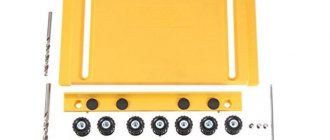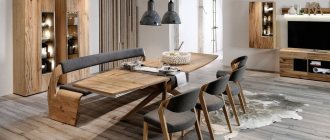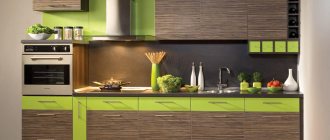A furniture jig is a device that can significantly simplify and speed up the process of production and assembly of furniture structures. This device, which can be manufactured in various designs, makes it possible for even novice craftsmen to make holes in elements of furniture structures with high quality and precision.
Drilling through the jig ensures precise placement of mounting holes
Template characteristics
Installing furniture hinges is an important step in assembling cabinets. A special insert template is used for this process. This element is made from different materials. You can purchase a ready-made part in a store or try to do everything yourself.
Work on installing facades is simplified by templates for furniture hinges. The finished element has many advantages. These include convenience, since there is a sketch for marking. Among the advantages of using a template are the strength of the structure, ease of use, and compactness of the product.
Do it yourself
Now let's talk about how you can make a homemade conductor. Let’s focus on a simple model, since it’s not worth doing something complicated with your own hands. It is better to immediately buy a quality tool from a trusted manufacturer.
Conductors are made from pieces of reinforcement, plastic and metal bars. You can take wood, but it is less durable.
Of the tools you will need to prepare a set consisting of:
Features of drawing up a drawing
You can make a template yourself if you have a drawing of the future design. To develop a sketch, you need to know what elements the template consists of.
Template structural details:
- Base. There are holes for drilling on it. This part of the furniture hinge installation template is key.
- Holder. The functions of an element include a limitation. The part is fixed to the door leaf, thereby eliminating shifts and deformations.
- Connecting parts. These elements help to adjust the template to specific door hinge sizes. The number of connecting elements depends on the complexity of the structure and the functions assigned to it. The primitive template has only 3 such details.
You can determine the amount of materials needed if you accurately determine the dimensions of the template. The design can be made more complex. You can add the installation of door locks to the functionality of the template.
Marking and fastening to swing doors - stages
1. The door is placed on a table or any flat surface. 2. Count 5 cm from the corners (edges) and place a dot in the places where the handle should be located. 3. Two mutually perpendicular lines are drawn through the points. The location of the first fastening is considered to be the point of first intersection. Be sure to use a square when drawing, applying it to the edges of the door. 4. The distance between the mounting holes is measured on the handle. 5. The distance between the holes is transferred from the intersection point. When installed horizontally, the displacement is carried out to the side, when installed vertically - downwards. The second attachment point is indicated. 6. Drill 2 mounting holes on the front side of the door. This operation should be performed as carefully as possible. 7. Mounting screws are inserted from the rear side. A handle is mounted on the front side. Screwing is done with a screwdriver.
The handles should be attached tightly and not wobble. If this problem exists, you should place washers under the screw caps and re-fasten them.
Anyone who intends to cope with such a task as screwing handles to the kitchen facades of retractable shelves will have to do similar manipulations. The only difference will be the size of the marks in the center of the drawers. Initially, the middle of the facade is calculated, after which 5 cm is counted down from the top edge. This point is the center of the installation. The length of the mounting hole is outlined from the center in different directions. Lines and handles are always horizontal. The façade is illuminated along with the frame. As a rule, longer screws are used.
Source
Furniture template for overhead hinges
The hinge template is designed to simplify the process of installing facades; it is often called a hinge jig. To use the sample, you do not need to have any special skills or knowledge. First you need to mark the location for the center of the fastener. Then the template is applied. Its nose should coincide with the applied mark.
Next you need to mark the hole for the strip. This can be done with a marker or a self-tapping screw. Then the template is applied so that its nose coincides with this mark. Next, the place for attaching the bowl is marked. Using a cutter, make a hole for the internal hinges. Self-tapping screws are used to secure the fittings.
Features of working with the template:
- The sample is made of durable materials, but it must be treated with care. For this reason, drilling through a template is prohibited. This may reduce the life of the product.
- When marking, be sure to step back 1.1-1.2 cm from the edge.
- Hinges from different manufacturers may have slight differences in size - the spacing between the centers of the screws. Then the template is used to determine the location for the cup. This hole is universal for all fasteners.
The number of hinges depends on the dimensions of the doors. The cutters are selected depending on the façade material. It is recommended to use reinforced self-tapping screws for fastening. During operation, the risk of damage to the fittings is reduced.
What is system 32 in the installation of furniture fasteners and accessories
In the production of cabinet furniture, they are increasingly moving away from standards, implementing some individually developed projects. However, there are certain design principles that remain unchanged. And at the international level.
Furniture system 32 is a general principle for standardizing the layout of furniture for further assembly. Its basis is a repeating step of 32 between the centers of the mounting holes with a distance of 37mm from the edge (taking into account the thickness of the edge).
System 32 is also followed by manufacturers of various furniture fittings and components. Thanks to this, the furniture maker does not have to think about and measure different distances in order to install guides for drawers of different types, handles of different sizes, lifting mechanisms, furniture hinges, etc. It is enough to remember a simple series of numbers (with time and growing experience in making furniture with your own hands, it is remembered like a multiplication table).
All this saves time and costs for the manufacturer in preparing furniture for assembly. System 32 also “subordinates” the settings of CNC machines, drilling and additive equipment.
Making your own template
Making a template for furniture hinges with your own hands follows a clear plan. It is important to follow the sequence of steps. If you follow all the rules, then no difficulties will arise in the process.
Stages of developing a template for loops:
- Selection and preparation of materials;
- Preparation of necessary tools;
- Development of template details;
- Final assembly of all elements.
Paper template for download
- To create a template yourself, you need to print a sample.
- According to its dimensions, make a blank from solid material, plastic or wood
- Attach the paper template to the workpiece
This is what you should get.
To create a workpiece you will need to take a drill, router, hammer, and jigsaw. You will also need tools for drawing markings. First you need to make a base. The optimal dimensions are 19x38 cm. A hole measuring 13.5x7 cm should be made in the center. The edges should be smooth. A router will help with this.
Bolts must be placed on the workpiece. It is important to maintain symmetry relative to the width of the base. The bolts must be buried in the structure so that they do not interfere with further manipulations. The hole is made wider than the connecting elements and additionally driven in using a hammer.
It is necessary to retreat 7 mm from the 13.5x7 cm holes and make small notches. Around an element with dimensions of 37.5x7 cm, notches are made on one side at a distance of 30 cm from each other.
A homemade template requires a holder measuring 2x5 cm and a length of 5.8 cm. You will need to install a limiter on one of the sides, which looks like a small block. This element will not allow the distance to shift when installing the facade.
Then all parts of the template are attached. Washers are installed under the bolts and nuts. This element increases the durability of the template. The manufacturing process does not require special skills or knowledge. It is enough to familiarize yourself in detail with the template development scheme.
Selection of materials for work
For the template, you can use plywood, chipboard or MDF. More durable structures are made of plexiglass and metal. You can take several materials for one template. So you can use chipboard for the base, and make the guides from a more durable material. It is easier to work with wood, as it is easier to process than glass and metal.
Required connecting elements:
- Bolts. You will need 6 pieces with a thickness of 6 mm and a length of 30 mm. To fix the connecting element, you need to have a 10 key.
- Nuts. Need 6 pieces. The main requirement for the element is convenient adjustment. Wing nuts are most often used.
- Washers. Their diameter should be 6 mm.
- Self-tapping screws. They are selected depending on the thickness of the remaining connecting parts.
Consumables and replacement attachments
For smooth operation of carpentry tools, you need to regularly replace their consumables. These include:
- Nozzles
- Cutting devices.
- Other accessories.
In order not to encounter a shortage of consumables during wood processing, it is better to take care of their supply in advance. Important consumables include:
- Jigsaw files. They are used when processing products made of chipboard and MDF and come in two types - cutting edges for fast and figured cutting. The first blades are equipped with a large tooth and are designated “T101B”. If you need to perform figured cutting, it is better to use models with the designation “T101AO”. Processing plexiglass, metal and other structures requires the selection of other types of hacksaw blades. However, their scope of application is limited.
- Sanding belts with different abrasiveness. Used to form edges and surfaces. In most cases, sanding materials with an abrasiveness of 80 (for rough grinding) and 120 (for finishing activities) are used for processing. Tapes with diagonal gluing demonstrate increased reliability.
Bits for fixing fasteners have different tip shapes. They are sold in sets or individually and are marked as follows:
- "PZ" or "PH". Used for Phillips head fasteners.
- "T". These bits are designed for screwing in confirms.
- With direct glitz. This type does not have a designation, but differs from others in appearance.
- Combined solutions. Provides two different ends. Suitable for devices with a cartridge.
Additional consumables that may be needed when making furniture at home include a magnetic holder. It is supplied with certain models of screwdrivers, while the element itself is sold in specialized retail outlets and is inexpensive. Using a magnetic holder, you can simplify the handling of electrical materials, which is especially useful when using bits.
For furniture production you will also need spiral drills and straight or edge cutters. When implementing specific tasks for processing and drilling holes, you need:
- Confirmed drills.
- Forstner drill.
- Bimetal core drills.
Initially, it seems that the carpentry equipment is quite extensive and requires several dozen devices and large financial costs. At the same time, for a novice furniture maker who is going to create primitive products, a basic set of tools is enough and only as the tasks become more complex, buy more professional tools.
Electrical accessories
Sawing and processing parts of furniture is a more labor-intensive process that cannot be handled with manual tools. It is recommended to stock up on electric tools for this.
Use different ways to create tools.
You may need:
- An electric drill is the most versatile power tool. Choose a model with a speed controller that is fairly lightweight.
- An electric jigsaw allows you to make beautiful cutouts and accurately and quickly cut wood or plywood.
- A grinding machine - with it you can bring the surface to the desired smoothness, make it neat and even, and give it a finished look.
- A construction hair dryer will be needed if you need to glue edges to varnished chipboard.
Electrical appliances are quite expensive. If you are furnishing your apartment and no longer plan to make furniture, you can rent equipment to save money.











